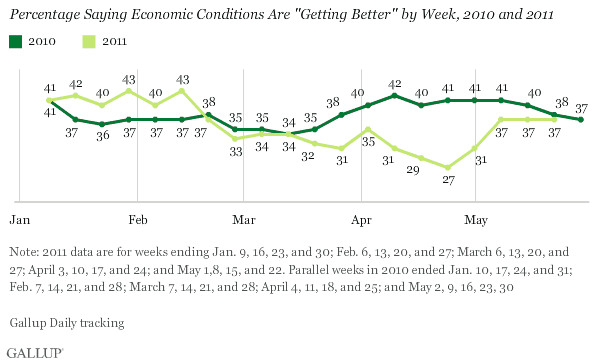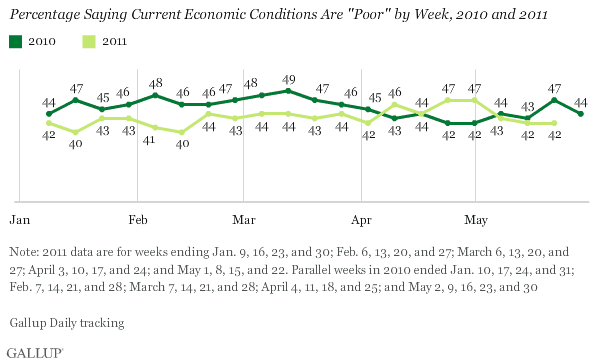PRINCETON, NJ -- Gallup's Economic Confidence Index remained at -25 in the week ending May 22, the level at which it has been since improving 10 percentage points in the week after Osama bin Laden's death. This is the highest weekly confidence reading since mid-February.

Economic confidence reached its peak so far this year at -18 in February and then generally declined through the week ending April 24, when it fell to -39 as gas prices surged and economic activity slowed. Confidence improved to -25 during the week after the announcement of bin Laden's death, coincident with the "rally effect" in President Obama's approval rating.
Gallup's Economic Confidence Index consists of two measures: one involving Americans' views about whether the U.S. economy is "getting better" or "getting worse" and the second involving Americans' ratings of current economic conditions as "excellent," "good," "only fair," or "poor." The improvement in economic confidence found so far in May is apparent in both measures.
Economic Expectations Match Those of 2010
Thirty-seven percent of Americans have said the U.S. economy is "getting better" in each of the past three weeks, the highest level since mid-February. The 37% in the week ending May 22 is essentially the same as in the comparable week a year ago.

"Poor" Ratings Improved in May
Forty-two percent of Americans rated current economic conditions "poor" in the week ending May 22 -- essentially the same as during the prior two weeks, and an improvement over April. Readings for the weeks ending May 8 and 15 are similar to those of comparable weeks in 2010. While this trend continued in the week ending May 22, 2011, the percentage of poor responses increased in the week ending May 23, 2010, before returning to trend in the following week. As a result, May 2011 trends seem generally consistent with the trend during the same weeks of May 2010.

Implications
Economic confidence surged in early May, coincident with Mother's Day celebrations and the death of bin Laden. What was generally interpreted as a good jobs report may have also helped increase confidence, despite an increase in the government's U.S. unemployment rate from 8.8% in March to 9.0% in April. Given these and any other potential sources of this surge in positivity, it is possible that confidence will fade if consumer sentiment is not reinforced by additional good economic reports.
The good news is the decline in oil and gas prices. Over the past week, pump prices fell 10 cents -- not much given current gas prices near $4 a gallon -- but still good for consumers. Americans expect that gas prices will hit $4.52 a gallon this year, so any movement in the opposite direction clearly qualifies as positive reinforcement toward improved economic confidence.
However, numerous economic factors now exist that usually do the reverse and act to decrease confidence. The U.S. economy, as well as the global economy, seems to be slowing down, according to numerous economic reports. The Dow has been down for three weeks in a row. Jobless claims continue to run above 400,000, suggesting there is not enough job growth to lower the unemployment rate. The battle over raising the federal debt limit seems to be heating up as the Treasury secretary warns of dire financial consequences if Congress does not act. And, there is a feeling of déjà vu as the European debt situation has surfaced once more, as it did about this time a year ago.
It may be that economic confidence continues to enjoy a "halo effect" from the bin Laden news and has been reinforced by a surprisingly quick decline in gas prices -- usually prices take much longer to decline than to go up. If so, and this improvement in confidence turns out to be transitory, the confidence gains of May could dissipate quickly in the weeks ahead. However, whatever the sources, improved economic confidence is something the U.S. economy badly needs right now.
Gallup.com reports results from these indexes in daily, weekly, and monthly averages and in Gallup.com stories. Complete trend data are always available to view and export in the following charts:
Daily: Employment, Economic Confidence and Job Creation, Consumer Spending
Weekly: Employment, Economic Confidence, Job Creation, Consumer Spending
Read more about Gallup's economic measures.
View our economic release schedule.
Survey Methods
Results are based on telephone interviews conducted on a weekly basis in 2011 through the week ending May 22 and in 2010 through the week ending May 30. For the week ending May 22, 2011, on the Gallup Daily tracking survey, interviews were conducted with a random sample of 3,456 adults, aged 18 and older, living in all 50 U.S. states and the District of Columbia.
For results based on the total sample of national adults, one can say with 95% confidence that the maximum margin of sampling error is ±3 percentage points.
Interviews are conducted with respondents on landline telephones and cellular phones, with interviews conducted in Spanish for respondents who are primarily Spanish-speaking. Each sample includes a minimum quota of 400 cell phone respondents and 600 landline respondents per 1,000 national adults, with additional minimum quotas among landline respondents for gender within region. Landline telephone numbers are chosen at random among listed telephone numbers. Cell phone numbers are selected using random-digit-dial methods. Landline respondents are chosen at random within each household on the basis of which member had the most recent birthday.
Samples are weighted by gender, age, race, Hispanic ethnicity, education, region, adults in the household, and phone status (cell phone only/landline only/both, cell phone mostly, and having an unlisted landline number). Demographic weighting targets are based on the March 2010 Current Population Survey figures for the aged 18 and older non-institutionalized population living in U.S. telephone households. All reported margins of sampling error include the computed design effects for weighting and sample design.
In addition to sampling error, question wording and practical difficulties in conducting surveys can introduce error or bias into the findings of public opinion polls.
For more details on Gallup's polling methodology, visit www.gallup.com.
